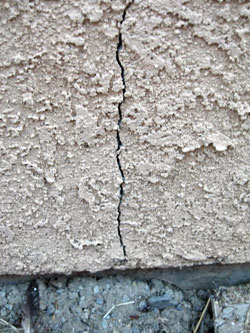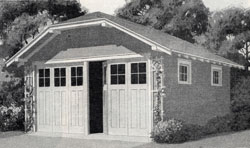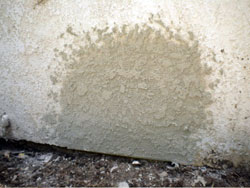Small Home Gazette, Winter 2012
Stucco Questions and Answers
 Can stucco be painted?
Can stucco be painted?
I wouldn’t. But if someone has already committed this sin, go ahead and add more. There are paints designed for stucco, but each paint layer negatively affects the exterior’s breathability (or “perm rating”). The less an exterior system breathes, the longer it takes for moisture to leave the wall cavity, creating an environment for mold. Stucco doesn’t bond to paint, so eventually you’ll have to sandblast it off your house. It’s a noisy, messy process that won’t make you popular with your neighbors. The best solution? Re-stucco by applying a thin layer of colored cement and a new texture.
 What should I do about the cracks in my stucco?
What should I do about the cracks in my stucco?
Not a thing in most cases. Small, hairline cracks are normal and generally don’t compromise stucco’s integrity. Stucco is not waterproof; rather it is inherently breathable so moisture can leave the wall cavity. It is the tarpaper layer that protects the interior of your home from the elements and the stucco protects the tarpaper. Two things can damage the tarpaper moisture barrier: structural shifting that creates a crack and ice. If cracks are more than 1/8” wide or there is an accompanying bulge, you should call us to take a look. Please note that caulking cracks doesn’t seal the moisture barrier and makes a restucco job more difficult.
 How long will stucco last?
How long will stucco last?
Longer than me and you. Grandpa Donnelly always said it should last for seven generations. I’ve found his words correct if a house is structurally sound. Stucco continues its hardening process with age. In fact, on some patch jobs, I’ve seen stucco holding the house together even though the framing has degraded. Or how about this? Stucco jobs that are more than 5,000 years old can still be evidenced today in the pyramids of Egypt! So why do people re-stucco? To freshen up or change color or texture.
 Can you match a patch to my original color and texture?
Can you match a patch to my original color and texture?
If we re-stucco the entire wall. That’s the only way to get a perfect match. And that’s not always a realistic choice for everyone. Our strategy for quality in this area is to have our crews carry sample boards of the 32 most common, conventional stucco colors and the “recipes” to achieve them. While the patch color can be lighter than the original for several months, we consistently hear from delighted customers about our color matching after curing.
What colors are available?
Depends on the type of stucco. There are two types of stucco: synthetic and conventional. Synthetic stucco offers most color choices available from paint stores and must be applied to a relatively smooth surface—and we can smooth out any surface! Conventional stucco consists of earth-based materials (crushed rock, iron oxide) so choices are limited to earth tones that are lighter in intensity.
How long does the process take?
Depends on the job. Think Stucco can perform small patch jobs in one day, while a typical re-stucco job (finish coat only) can take one to three “good weather” days. For larger, more complex jobs (additions, new construction, restuccos with significant patching), the process may stretch over several weeks.
What is the best temperature for stucco application?
Above freezing. Grandpa Donnelly used to say “No stucco between Thanksgiving and Easter!” After the browning and finish coats set, stucco must avoid freezing conditions for 48 hours. If you see crumbling stucco, it likely froze during the setting period. We err on the side of caution on this one. My kids often ask if I’m a weatherman or a stucco guy because I’m analyzing the weather so much.
 What are these ugly stains and how can I clean my stucco?
What are these ugly stains and how can I clean my stucco?
Mother Nature interacts with your stucco. Most stains are the result of concentrated dirty water runoff (rain + pollen + dust + organic material) absorbed into the stucco’s porous surface. To clean stucco, start by saturating the entire wall from the bottom up to prevent absorption of dirty water created during cleaning.
Use a hard, nylon-bristled brush with mild laundry detergent to scrub the stain. If unsuccessful, move to more stringent cleaning solvents like trisodium phosphate (TSP) or Lime-A-Way. As a last resort, you can use diluted muriatic acid but be careful as it can damage plants, some building materials, skin and eyes.











